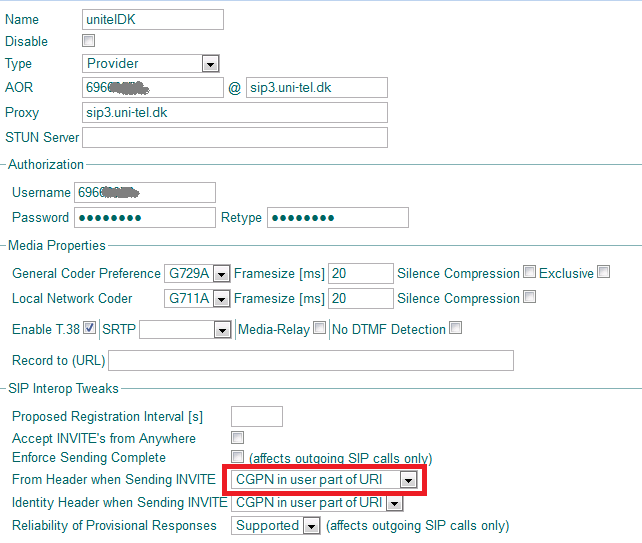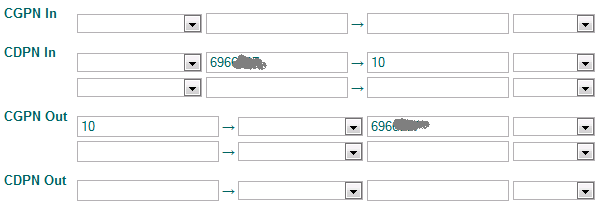Howto:Uni-tel SIP Provider Compatibility Test: Difference between revisions
m New page: == Summary == '''SIP Provider: Deltacom''' The provider has achieved 79,17% of all possible test points (95 on total of 120 Points). For more information on the test rating, please refer... |
|||
| (39 intermediate revisions by 2 users not shown) | |||
| Line 1: | Line 1: | ||
== Summary == | == Summary == | ||
'''SIP Provider: | '''SIP Provider: Uni-tel A/S''' | ||
The provider has achieved | The provider has achieved 93,24% of all possible test points (124 on total of 133 Points). For more information on the test rating, please refer to [[Howto:SIP_Interop_Test_Description#Summary|Test Description]] | ||
| Line 16: | Line 16: | ||
* Supported Codecs by the provider | * Supported Codecs by the provider | ||
** G711 a/u | ** G711 a/u | ||
== Current test state == | == Current test state == | ||
<!-- {{Template:Compat Status "tested"}} --> | <!-- {{Template:Compat Status "tested"}} --> | ||
<!-- {{Template:Compat Status "in progress"}}--> | <!-- {{Template:Compat Status "in progress"}} --> | ||
{{Template:Compat Status "certified"|certificate= | {{Template:Compat Status "certified"|certificate=IP_Telefoni_Uni-Tel_SIP_Provider_-_product-cert.pdf}} | ||
<!-- {{Template:Compat Status "rejected"}} --> | <!-- {{Template:Compat Status "rejected"}} --> | ||
Testing of this product has been finalized in August, 2012. | Testing of this product has been finalized in 28th August, 2012. | ||
== Testing Enviroment == | == Testing Enviroment == | ||
| Line 32: | Line 31: | ||
[[Image:HFO_SIP_Compatibility_Test_5.PNG]] | [[Image:HFO_SIP_Compatibility_Test_5.PNG]] | ||
This scenario describes a setup where the PBX and phones are in a private network | This scenario describes a setup where the PBX and phones are in a private network. | ||
== Test Results == | == Test Results == | ||
| Line 51: | Line 50: | ||
|---- | |---- | ||
|Call using g723 | |Call using g723 | ||
| | |No | ||
|---- | |---- | ||
|Call using g729 | |Call using g729 | ||
| | |No | ||
|---- | |---- | ||
|Call using g722 | |Call using g722 | ||
| | |No | ||
|---- | |---- | ||
|Overlapped sending | |Overlapped sending | ||
| | |No | ||
|---- | |---- | ||
|'''Early media channel''' | |'''Early media channel''' | ||
| Line 66: | Line 65: | ||
|---- | |---- | ||
|Fax using T.38 | |Fax using T.38 | ||
| | |Yes | ||
|---- | |---- | ||
|CGPN can be suppressed | |CGPN can be suppressed | ||
| | |Yes | ||
|---- | |---- | ||
|CLIP no screening | |CLIP no screening | ||
| | |Yes (only for Danish numbers) | ||
|---- | |---- | ||
|Reverse Media Negotiation | |Reverse Media Negotiation | ||
| | |Yes | ||
|---- | |---- | ||
|'''Long time call possible''' | |'''Long time call possible''' | ||
| Line 84: | Line 83: | ||
|---- | |---- | ||
|NAT Detection | |NAT Detection | ||
| | |Yes | ||
|---- | |---- | ||
|'''Voice Quality OK?''' | |'''Voice Quality OK?''' | ||
| Line 90: | Line 89: | ||
|---- | |---- | ||
|Redundancy Mechanism | |Redundancy Mechanism | ||
|Yes | |||
|---- | |||
|SIP over TCP | |||
|Yes | |Yes | ||
|} | |} | ||
| Line 204: | Line 206: | ||
Here's the configuration of the SIP gateway interface. | Here's the configuration of the SIP gateway interface. | ||
[[Image: | [[Image:Uni-tel_SIP_Provider_Compatibility_Test_1.png]] | ||
No need to use STUN, so It's optional. | |||
Fixed AOR should not be used to send different CPGN since only "FROM" header it's used for CGPN and not Prefered-ID field on SIP Invite. | |||
=== Number Mapping === | === Number Mapping === | ||
[[Image: | [[Image:Uni-tel_SIP_Provider_Compatibility_Test_2.png]] | ||
=== Route Settings === | === Route Settings === | ||
Uni-tel, as most SIP Providers do, doesn't support overlap sending. You must enable the enblock sending of the phone number. You can do this by enabling '''Force enblock''' in the appropriate outgoing Route. | |||
The second setting you must check is Interworking(QSIG,SIP). This feature must be enabled to properly relay supplementary services, like Hold over the SIP Trunk. If this check-box is unchecked only basic call Information like connect and disconnect will be forwarded by the Gateway. | The second setting you must check is '''Interworking(QSIG,SIP)'''. This feature must be enabled to properly relay supplementary services, like Hold over the SIP Trunk. If this check-box is unchecked only basic call Information like connect and disconnect will be forwarded by the Gateway. | ||
[[Image:Uni-tel_SIP_Provider_Compatibility_Test_3.png]] | |||
=== Redundancy === | === Redundancy === | ||
Redundancy | Redundancy could be done by DNS SRV. | ||
When resolving the proxy name the provider may give us several IP address in the SRV record. | |||
We select one address and keep the others as fallback. | |||
Methods used to select one address of several returned addresses are also used for load balancing. | |||
Whether load balancing and/or redundancy is implemented only depends on priority values of the returned addresses. | |||
=== Known Issues === | === Known Issues === | ||
Latest revision as of 15:24, 31 August 2012
Summary
SIP Provider: Uni-tel A/S
The provider has achieved 93,24% of all possible test points (124 on total of 133 Points). For more information on the test rating, please refer to Test Description
- Features:
- Direct Dial In
- DTMF
- Redundancy Mechanism
- Supported Codecs by the provider
- G711 a/u
Current test state

Testing of this product has been finalized in 28th August, 2012.
Testing Enviroment
Scenario NAT
This scenario describes a setup where the PBX and phones are in a private network.
Test Results
For more information on the test procedure, please read the following wiki article: SIP Interop Test Description. Bold lines in the test results indicate a KO-criteria.
Basic Call
| Tested feature | Result |
|---|---|
| Call using g711a | Yes |
| Call using g711u | Yes |
| Call using g723 | No |
| Call using g729 | No |
| Call using g722 | No |
| Overlapped sending | No |
| Early media channel | Yes |
| Fax using T.38 | Yes |
| CGPN can be suppressed | Yes |
| CLIP no screening | Yes (only for Danish numbers) |
| Reverse Media Negotiation | Yes |
| Long time call possible | Yes |
| External Transfer | Yes |
| NAT Detection | Yes |
| Voice Quality OK? | Yes |
| Redundancy Mechanism | Yes |
| SIP over TCP | Yes |
Direct Dial In
| Tested feature | Result |
|---|---|
| Inbound(Provider -> Innovaphone) | Yes |
| Outbound(Innovaphone -> Provider) | Yes |
DTMF
| Tested feature | Result |
|---|---|
| DTMF tones sent correctly | Yes |
| DTMF tones sent correctly via SIP-Info | Yes |
| DTMF tones received correctly | Yes |
Hold/Retrieve
| Tested feature | Result |
|---|---|
| Call can be put on hold | Yes |
| Held end hears music on hold / announcement from PBX | Yes |
Transfer with consultation
| Tested feature | Result |
|---|---|
| Call can be transferred | Yes |
| Held end hears music on hold | Yes |
Transfer with consultation (alerting only)
| Tested feature | Result |
|---|---|
| Call can be transferred | Yes |
| Held end hears music on hold or dialling tone | Yes |
| Call returns to transferring device if the third Endpoint is not available | Yes |
Blind Transfer
| Tested feature | Result |
|---|---|
| Call can be transferred | Yes |
| Held end hears dialling tone | Yes |
Broadcast Group & Waiting Queue
| Tested feature | Result |
|---|---|
| Caller can make a call to a Broadcast Group | Yes |
| Caller can make a call to a Waiting Queue | Yes |
| Announcement if nobody picks up the call | Yes |
Configuration
Firmware version
All innovaphone devices use V9hf15 as firmware.
SIP - Trunk
Here's the configuration of the SIP gateway interface.
No need to use STUN, so It's optional.
Fixed AOR should not be used to send different CPGN since only "FROM" header it's used for CGPN and not Prefered-ID field on SIP Invite.
Number Mapping
Route Settings
Uni-tel, as most SIP Providers do, doesn't support overlap sending. You must enable the enblock sending of the phone number. You can do this by enabling Force enblock in the appropriate outgoing Route.
The second setting you must check is Interworking(QSIG,SIP). This feature must be enabled to properly relay supplementary services, like Hold over the SIP Trunk. If this check-box is unchecked only basic call Information like connect and disconnect will be forwarded by the Gateway.
Redundancy
Redundancy could be done by DNS SRV.
When resolving the proxy name the provider may give us several IP address in the SRV record. We select one address and keep the others as fallback. Methods used to select one address of several returned addresses are also used for load balancing. Whether load balancing and/or redundancy is implemented only depends on priority values of the returned addresses.



